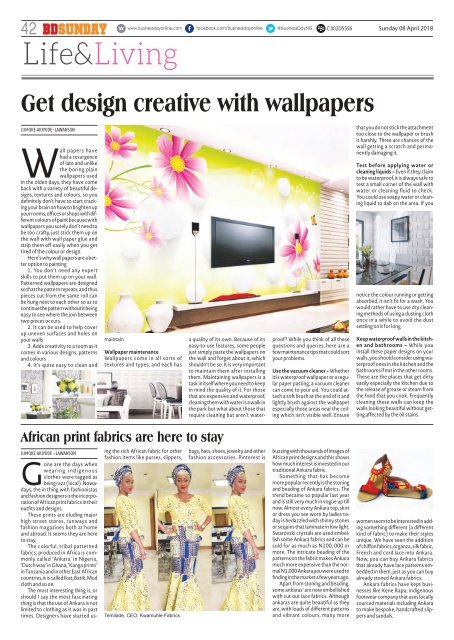BusinessDay 08 Apr 2018
Create successful ePaper yourself
Turn your PDF publications into a flip-book with our unique Google optimized e-Paper software.
42<br />
C002D5556<br />
Sunday <strong>08</strong> <strong>Apr</strong>il <strong>2018</strong><br />
Life&Living<br />
Get design creative with wallpapers<br />
JUMOKE AKIYODE-LAWANSON<br />
Wall papers have<br />
had a resurgence<br />
of late and unlike<br />
the boring plain<br />
wallpapers used<br />
in the olden days, they have come<br />
back with a variety of beautiful designs,<br />
textures and colours, so you<br />
definitely don’t have to start cracking<br />
your brain on how to brighten up<br />
your rooms, offices or shops with different<br />
colours of paint because with<br />
wallpapers you surely don’t need to<br />
be too crafty, just stick them up on<br />
the wall with wall paper glue and<br />
strip them off easily when you get<br />
tired of the colour or design.<br />
Here’s why wall papers are a better<br />
option to painting<br />
1. You don’t need any expert<br />
skills to put them up on your wall.<br />
Patterned wallpapers are designed<br />
so that the pattern repeats, and thus<br />
pieces cut from the same roll can<br />
be hung next to each other so as to<br />
continue the pattern without it being<br />
easy to see where the join between<br />
two pieces occurs.<br />
2. It can be used to help cover<br />
up uneven surfaces and holes on<br />
your walls<br />
3. Adds creativity to a room as it<br />
comes in various designs, patterns<br />
and colours<br />
4. It’s quite easy to clean and<br />
maintain<br />
Wallpaper maintenance<br />
Wallpapers come in all sorts of<br />
textures and types, and each has<br />
a quality of its own. Because of its<br />
easy-to-use features, some people<br />
just simply paste the wallpapers on<br />
the wall and forget about it, which<br />
shouldn’t be so. It is very important<br />
to maintain them after installing<br />
them. Maintaining wallpapers is a<br />
task in itself where you need to keep<br />
in mind the quality of it. For those<br />
that are expensive and waterproof,<br />
cleaning them with water is a walk in<br />
the park but what about those that<br />
require cleaning but aren’t water-<br />
proof? While you think of all these<br />
questions and queries, here are a<br />
few maintenance tips that could sort<br />
your problems.<br />
Use the vacuum cleaner – Whether<br />
it is waterproof wallpaper or a regular<br />
paper pasting, a vacuum cleaner<br />
can come to your aid. You could attach<br />
a soft brush at the end of it and<br />
lightly brush against the wallpaper<br />
especially those areas near the ceiling<br />
which isn’t visible well. Ensure<br />
that you do not stick the attachment<br />
too close to the wallpaper or brush<br />
it harshly. Three are chances of the<br />
wall getting a scratch and permanently<br />
damaging it.<br />
Test before applying water or<br />
cleaning liquids – Even if they claim<br />
to be waterproof, it is always safe to<br />
test a small corner of the wall with<br />
water or cleaning fluid to check.<br />
You could use soapy water or cleaning<br />
liquid to dab on the area. If you<br />
notice the colour running or getting<br />
absorbed, it isn’t fit for a wash. You<br />
would rather have to use dry cleaning<br />
methods of using a dusting cloth<br />
once in a while to avoid the dust<br />
settling on it for long.<br />
Keep waterproof walls in the kitchen<br />
and bathrooms – While you<br />
install these paper designs on your<br />
walls, you should consider using waterproof<br />
ones in the kitchen and the<br />
bathrooms if not in the other rooms.<br />
These are the places that get dirty<br />
easily especially the kitchen due to<br />
the release of grease or steam from<br />
the food that you cook. Frequently<br />
cleaning these walls can keep the<br />
walls looking beautiful without getting<br />
affected by the oil stains.<br />
African print fabrics are here to stay<br />
JUMOKE AKIYODE -LAWANSON<br />
Gone are the days when<br />
wearing indigenous<br />
clothes were tagged as<br />
being razz (local). Nowadays,<br />
the in thing with fashionistas<br />
and fashion designers is the incorporation<br />
of African print fabrics in their<br />
outfits and designs.<br />
These prints are eluding major<br />
high street stores, runways and<br />
fashion magazines both at home<br />
and abroad. It seems they are here<br />
to stay.<br />
The colorful, tribal patterned<br />
fabrics, produced in Africa is commonly<br />
called ‘Ankara’ in Nigeria,<br />
‘Dutch wax’ in Ghana, ‘Kanga prints’<br />
in Tanzania and in other East African<br />
countries, it is called Ikat, Batik, Mud<br />
cloth and so on.<br />
The most interesting thing is, or<br />
should I say the most fascinating<br />
thing is that the use of Ankara is not<br />
limited to clothing as it was in past<br />
times. Designers have started us-<br />
ing the rich African fabric for other<br />
fashion items like purses, slippers,<br />
Temilade, CEO, Kwamuhle Fabrics<br />
bags, hats, shoes, jewelry and other<br />
fashion accessories. Pinterest is<br />
buzzing with thousands of images of<br />
African print designs and this shows<br />
how much interest is invested in our<br />
traditional Ankara fabric.<br />
Something that has become<br />
more popular recently is the stoning<br />
and beading of Ankara fabrics. The<br />
trend became so popular last year<br />
and is still very much in vogue up till<br />
now. Almost every Ankara top, skirt<br />
or dress you see worn by ladies today<br />
is bedazzled with shinny stones<br />
or sequins that laminate in low light.<br />
Swarovski crystals are used embellish<br />
some Ankara fabrics and can be<br />
sold for as much as N100, 000 or<br />
more. The intricate beading of the<br />
patterns on the fabric makes Ankara<br />
much more expensive than the normal<br />
N1,000 Ankara you were used to<br />
finding in the market a few years ago.<br />
Apart from stoning and beading,<br />
some ankaras’ are now embellished<br />
with cut out lace fabrics. Although<br />
ankaras are quite beautiful as they<br />
are, with loads of different patterns<br />
and vibrant colours, many more<br />
women seem to be interested in adding<br />
something different (a different<br />
kind of fabric) to make their styles<br />
unique. We have seen the addition<br />
of chiffon fabrics, organza, silk fabric,<br />
French and cord lace into Ankara.<br />
Now, you can buy Ankara fabrics<br />
that already have lace patterns embedded<br />
in them, just as you can buy<br />
already stoned Ankara fabrics.<br />
Ankara fabrics have kept businesses<br />
like Kene Rapu; indigenous<br />
footwear company that uses locally<br />
sourced materials including Ankara<br />
to make bespoke, handcrafted slippers<br />
and sandals.


















